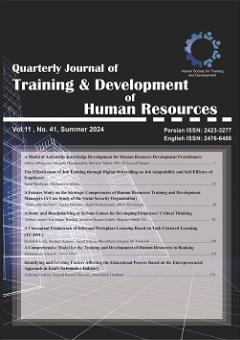A Comprehensive Model for the Training and Development of Human Resources in Banking
Subject Areas :Mohammad afkaneh 1 , zahra jafari 2
1 - Assistant Professor, Faculty of Human Sciences, Shahid University, Tehran
2 - Master of Public Administration, Shahid University, Tehran
Keywords: Comprehensive model of training, human resources development, bank training system, training and improvement, Sina Bank,
Abstract :
Organizations must proactively invest in employee training and development to navigate the ever-evolving landscape and remain competitive. The primary objectives of such initiatives include boosting productivity and profitability, gaining a competitive edge, and ensuring sustainable growth. Accordingly, this study aimed to develop a comprehensive model for training and developing human resources in Sina Bank. A qualitative research approach based on thematic analysis was therefore adopted. Data collection involved both bibliographic research and fieldwork. The bibliographic research involved searches across diverse research platforms and databases, along with an examination of scholarly documents and sources. The fieldwork included semi-structured interviews with experts, administrators, and education professionals. The study's statistical population consisted of administrators, professors, specialists, and planners within the education and human resources domains. The participants were selected through purposive sampling method and continued until theoretical saturation of data. The theme analysis approach was utilized, resulting in the extraction and coding of 186 statements, which were subsequently organized into three overarching categories: The main category, sub-category, and sub-sub-category. The research outcomes culminated in the design of Sina Bank's human resources training and development model, comprising three primary categories: Input, process, and output. The input category consisted of three sub-categories: Top managers' support for education, formulation of strategies, and the fostering of a learning and development culture. The process category was divided into three sub-categories: Needs identification, education planning, and education implementation. Finally, the output category encompassed two sub-categories: Evaluation and results.
